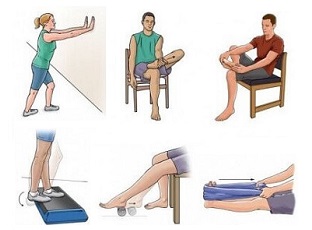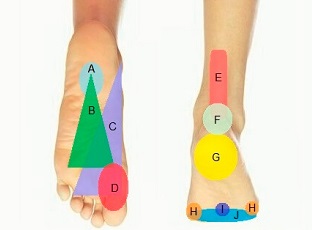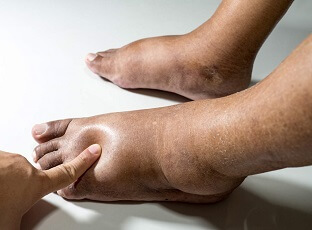- Home
- Common Foot Problems
- Jones Fracture
Jones Fracture
Written By: Chloe Wilson BSc(Hons) Physiotherapy
Reviewed By: FPE Medical Review Board
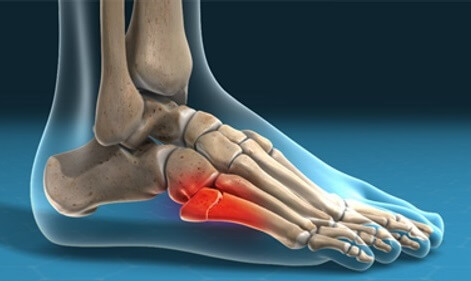
A Jones Fracture is a type of foot fracture.
It occurs when there is a break in a specific part of the fifth metatarsal bone – the long bone on the outer side of the foot.
Jones Fractures are common in athletes and active individuals but can occur in anyone. They typically occur when the foot forcefully bends and twists inwards, particularly when on tiptoes.
It causes pain, swelling, bruising and difficulty walking and there may be a lump on the outside of the foot. Complications such as slow healing are common due to lack of blood flow to the area.
Here we will look at what a Jones Fracture is, where it occurs, common causes and symptoms and the best treatment options.
What Is a Jones Fracture?
A Jones fracture is a break located in the fifth metatarsal – the long bone that connects the pinky toe to the midfoot. It occurs in a specific area of the bone, between the middle and the proximal end of the fifth metatarsal (close to the midfoot), and is named after Sir Robert Jones, who first described this injury in 1902.
It helps to understand a little about foot anatomy as there are lots of different types of fifth metatarsal fracture, depending on where exactly the break occurs.
The fifth metatarsal can be thought of as having different areas:
Metatarsal Base
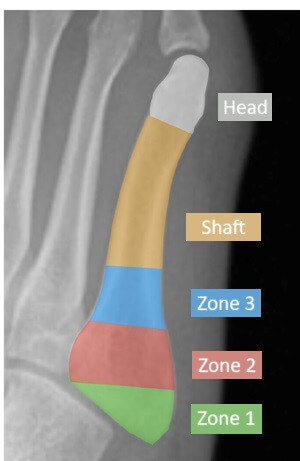
The base or proximal part of the metatarsal, is where the bone joins the midfoot. The base is subdivided into 3 different zones
- Zone 1: The tuberosity or styloid, articulates with the cuboid. Fractures here are known as avulsion fractures or Pseudo Jones fracture
- Zone 2: A small area known as the metaphysis, intermetatarsal zone or proximal diaphysis, articulates with the fourth metatarsal. Jones fractures occur in zone 2
- Zone 3: the diaphyseal area, 1.5cm+ from the tuberosity, extending to the metatarsal shaft. Fractures here are usually stress fractures
Metatarsal Shaft
The metatarsal shaft is the long, middle section of the bone. Fractures here may be Dancer’s fractures or stress fractures.
Metatarsal Head
The metatarsal head is the top part of the bone, nearest the toes. Fractures here are known as metatarsal head fractures.
Jones Fractures occur in zone 2, a specific area of the bone which has a particularly poor blood supply, known as a vascular watershed. This limited circulation means Jones fractures can be notoriously slow to heal and are often associated with problems such as non-union (30-50% of cases) and re-fracture (33% of cases).
Distinguishing a Jones fracture from other types of fifth metatarsal fractures is critical because treatment approaches differ significantly due to the poor blood supply. Jones fractures are regarded as the most serious type of fifth metatarsal fracture due to the high risk of delayed union or non-union.
Jones Fracture Causes
Common causes of Jones fractures are:
- Twisting Injuries: Rolling the ankle or an awkward landing can exert force on the outer edge of the foot, leading to a break, particularly if your foot is pointed down or you are on tiptoes
- Direct Impact: A heavy object falling on the foot or a sudden blow can cause an acute fracture.
- Overuse or Repetitive Stress: Common in athletes who engage in high-impact activities like running or jumping or have to quickly change direction when running. Jones fractures are particularly common in activities like basketball, dancing, football and soccer.
- Fall: Jones fractures may be caused by a trip, slip or fall e.g. tripping over a step or kerb, or slipping on a wet floor, especially in elderly people
- Foot Biomechanics: High arches, flat feet, or improper footwear can increase pressure and stress on the fifth metatarsal, making it more prone to fractures.
- Osteoporosis: People with osteoporosis, where the bones weaken and become more brittle, are more prone to bone fractures
- Age & Gender: Jones fractures are most common in men in their 20’s and women in their 60’s
Jones Fracture Symptoms
Common symptoms of a Jones fracture may include:
- Localized Pain: Sharp pain on the outer edge of the foot, particularly around the midfoot. Jones fracture pain is typically worsens with activity and improves slightly with rest. There is usually an abrupt onset of outer foot pain following a specific injury
- Swelling and Bruising: Noticeable swelling along the outer foot, often accompanied by bruising near the base of the fifth metatarsal.
- Difficulty Bearing Weight: Walking or standing may be painful, and severe cases can make weight-bearing nearly impossible.
- Chronic Symptoms: If left untreated, the fracture may lead to persistent discomfort and instability.
It’s important to differentiate these symptoms from other foot injuries like ankle sprains or avulsion fractures, as misdiagnosis can delay appropriate treatment.
Diagnosing Jones Fractures
To accurately diagnose a Jones Fracture, you healthcare provider will start by taking a history to find out about your symptoms. They will want to know about how and when the pain started, what aggravates or eases your symptoms, any previous foot injuries and underlying medical conditions.
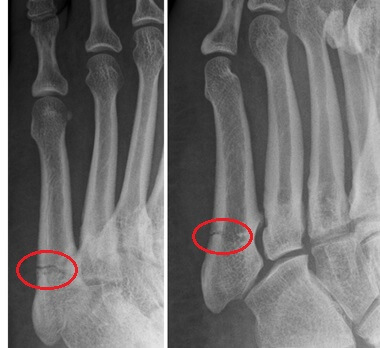
They will also carry out a physical examination, inspecting your foot for any areas of tenderness or bruising, looking at your foot movements and assessing your strength, function and balance.
If they suspect a Jones Fracture, they will send you for imaging studies such as an x-ray, MRI or CT scan of the foot.
These will help to show any damage to the bones or soft tissues, the extent of the damage, and any associated injuries so they can determine the best course of treatment.
Differential Diagnosis
There are a few other injuries that present in a similar way to Jones fractures:
- Ankle Sprain: over-stretching or tearing of one the ankle ligaments resulting in pain and instability. Find Out More >
- Avulsion Fractures: where a small piece of bone is pulled off the base of the metatarsal due to overstretching one of the ligaments or tendons. Most common type of fifth metatarsal fracture. Find Out More >
- Stress Fractures: a small crack or break in the fifth metatarsal from repetitive overuse. Find Out More >
- Dancers Fracture: a long, oblique fracture of the shaft of the fifth metatarsal caused by a strong twisting force. Find Out More >
- Peroneal Tendonitis: inflammation and degeneration of one of the outer foot tendons, usually due to overuse, abnormal foot biomechanics or an ankle injury. Find Out More >
- Cuboid Syndrome: where the cuboid bone shifts slightly out of position, usually due to a twisted ankle or repetitive movements, often making it difficult to push up onto tiptoes. Find Out More >
It is really important to have an accurate diagnosis for outer foot pain as they all require different treatment.
Jones Fracture Treatment
Jones fracture treatment depends on the severity and type of fracture as well as the activity levels of the individual.
#CommissionEarned from Amazon on qualifying purchases
Non-Surgical Treatment
- Immobilization: The foot is placed in a cast, or special boot to restrict movement and allow the fracture to heal in the correct position
- Rest and Reduced Weight Bearing: Crutches are often necessary to completely offload the affected foot. Most people with a Jones fracture will need to be non-weight bearing or partial weight bearing for at least 6 weeks
- Swelling Management: it is important to reduce the swelling as quickly as possible to reduce pain and speed up healing. Regularly applying an ice pack for 10-15 minutes and keeping the foot elevated ideally above the level of the heart, e.g. on a leg elevation cushion, can really help
- Medication: over-the-counter pain relievers e.g. paracetamol/Tylenol or non-steroidal anti-inflammatories e.g. ibuprofen/Advil can help to reduce pain and inflammation
- Physical Therapy: Once healing begins, therapy helps restore strength and mobility. Exercises are really important, helping to reduce Jones fracture pain, improve range of motion and aid functional recovery.
- Bone Stimulation: Low-intensity ultrasound or electrical bone stimulation may be used to promote healing in stubborn fractures.
- Closed Reduction: if the bones are out of alignment, your doctor may perform closed reduction to push/pull the bones back into the right place. This is usually done under local anaesthetic and you will then need to wear a cast or boot while the fracture heals
Non-surgical treatment is typically reserved for less severe fractures, individuals with low activity levels, or elderly patients who are at high risk of complications from surgery.
Jones Fracture Surgery
Jones fracture surgery is usually recommend for athletes, if there is significant displacement of the bones (more than 3mm) or in the case of delayed healing or non-union.
1. Internal Fixation
The bones are realigned into the correct position and then fixed in place while the fracture heals. The bones may be fixed with:
- Plates/Screws: metal plates and/or screws are used to hold the pieces of bone together. Screws are the most common fixing device used with Jones fractures.
- Rods: a small metal rod is inserted through the centres of the bone fragments
- Pins/Wires: pins and/or wires are used to secure broken fragments of bone that are too small to be held by other methods. Pin or wire fixation is often combined with rods or plates for maximum stability
2. Bone Graft
If a Jones fracture is severely displaced or in cases of delayed healing or non-union, a bone graft may be used. This is where the damaged fragments of bone are removed and replaced with transplanted bone tissue to stabilise the fracture. The bone may come from another part of your body e.g. hip, a donor or the surgeon may use an artificial replacement piece.
Once the bone graft is in position, the fracture site will usually be stabilised with one of the internal fixation methods above while the bone heals.

Jones fracture surgery is usually performed as a day-case meaning you don’t have to stay in hospital overnight. You will need to wear a cast or boot initially and may need crutches in the short term while the fracture heals.
Depending on the type of surgery you may need to limit how much weight can go through your foot for up to 8 weeks, typically non-weight bearing for 1-3 weeks then partial weight bearing for a few weeks.
In most cases, the metal work is left in situ, but if it starts to cause any pain, it can be removed once the fracture has healed.
Jones Fracture Recovery
Most people make a full recovery from a Jones fracture, but it can take time.
You should have follow-up appointments every 2-3 weeks where your doctor will reassess the foot and check fracture healing using x-rays. This will continue until you can walk unaided without any pain and radiographs show complete healing of the fracture.
You can usually resume weight-bearing activities within 6–8 weeks and then gradually increase your activity levels. It usually takes 3-4 months to return to all your normal activities including sports following surgery, but often takes longer (4-6 months) without non-surgical treatment.
Physical therapy is an important part of the Jones fracture recovery, with or without surgery, and rehabilitation will focus on exercises to improve
- Strength: using resistance bands
- Flexibility: calf stretches and ankle mobility exercises
- Balance: single leg standing
Swimming are cycling are good places to start for regaining cardiovascular fitness as they place minimal impact through the foot. Athletes may require additional time and training before returning to high-impact sports.
Surgery typically results in faster Jones fracture recovery time and a reduced risk of non-union and re-injury. However, it carries risks such as infection, hardware irritation, or nerve damage. Re-injury risk is high with non-surgical treatment - up to 33% will re-fracture.
Most people with a Jones fracture make a full recovery, but the timeframe will depend on age, normal activity levels, co-morbidities and treatment. Swelling may persist for up to 12 months.
Tips For Optimal Recovery

- Keep your foot elevated any time you are sitting, ideally above hip height. This helps to reduce swelling in the foot. In bed, prop your leg up on a pillow or use a special leg elevation cushion to keep it elevated overnight
- Ice your foot for 10-15 minutes regularly during the day to help reduce Jones fracture pain and swelling
- Follow your healthcare provider’s guidelines on weight-bearing. Do not put any weight through your foot until they say you can
- Avoid smoking as tobacco products can delay healing
- Avoid high-impact activities until fully cleared
- Wear supportive footwear to prevent re-injury
FAQ's About Jones Fractures
What Are The Jones Fracture Classification Types?
What Are The Jones Fracture Classification Types?
Jones fractures can be classified into three different types:
- Acute Jones Fracture: A complete break resulting from a sudden impact or trauma.
- Stress Fracture: A hairline crack that develops gradually, caused by repetitive stress or overuse.
- Non-Union Jones Fracture: When the fracture fails to heal properly, often requiring surgical intervention. Non-union rates are high, around 15-30%
What Are The Long-Term Effects Of Jones Fracture?
What Are The Long-Term Effects Of Jones Fracture?
Most people will make a full recovery within 3-6 months of a Jones fracture but there can be ongoing problems. There is a high risk of delayed union or non-union, with Jones fractures, particularly when they are treated conservatively. There is also a 33% risk of re-fracture.
Ongoing pain is a common problem with non-union, and can also occur following Jones fracture surgery is the screw shifts out of place, in which case the screw will be removed.
Jones vs Dancers Fracture
Jones vs Dancers Fracture
A Jones fracture occurs in the base of the fifth metatarsal, specifically in zone 2, the area between the metatarsal shaft and the tuberosity. Surgery is typically the treatment of choice with a Jones fracture as the poor blood supply often causes delayed healing or non-union.
A Dancer’s fracture occurs in the middle part of the fifth metatarsal bone, the shaft. Surgery is much less common with Dancer’s fractures. The symptoms will be similar for both. Avulsion fractures at the base of the fifth metatarsal are often incorrectly referred to as Dancer’s fractures.
Jones Fracture Summary
A Jones fracture is a unique and often challenging foot injury that requires timely diagnosis and appropriate treatment.
While healing can be prolonged due to limited blood supply, modern techniques and therapies have significantly improved outcomes for patients with Jones fractures.
Jones fracture symptoms typically comprise of outer foot pain, swelling and bruising, difficulty walking and ongoing symptoms.
Most cases of Jones fractures are treated with surgery, typically internal fixation with metal screws due to improved outcome measures. With or without surgery, weight-bearing is often limited initially and you will need to wear a cast or boot for a few weeks while the fracture heals.
There are lots of other types of fifth metatarsal fracture – it is important to get an accurate diagnosis to ensure you get the right treatment.
You may also be interested in the following articles
- Outer Foot Pain
- Foot Stress Fractures
- Foot Pain When Walking
- How To Do Stairs With Crutches
- How To Reduce Foot Swelling
Related Articles
References
- Proximal Fifth Metatarsal Fractures: Anatomy, Classification, Treatment and Complications. Archives Of Trauma Research
- Is the Diagnosis of fifth Metatarsal Fracture Type Consistent? An Interobserver Reliability Study. American Orthopedic Foot & Ankle Society
- 5th Metatarsal Fracture. National Library Of Medicine
- Proximal Fifth Metatarsal Fractures. UpToDate
Page Last Updated: 2nd December, 2024
Next Review Due: 2nd December, 2026
